But what was that boat on the roofrack?
The boat
National rules for small racing boats
National rules for church boats
At the races
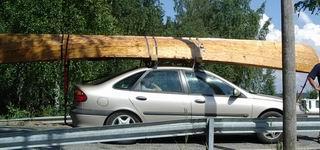
Back to main page.
The boat is a sculling racer built according to the Finnish national
rules for small boats by a distinguished builder, Mr. Liukkonen.
The boat is rather old, I bought it second (or third, fourth...) hand
in 2000. No match to the new boats in serious racing, but very nice
for the "sunday sculler".
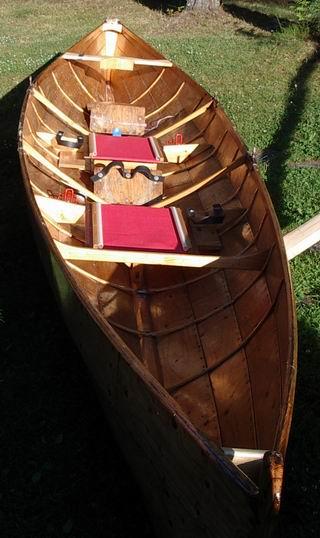
The national rules have their roots in the history of what is known
as the "Sulkava race",
(Or see the official site.)
today the biggest rowing/sculling event in
the world. Over 10.000 participants in 2001, 2002 and 2003!. Less than 10000
in 2004, though :-(
Basically, the rules define two boat types, a "small" sculling boat
and a church boat, that are close to traditional, yet fast to scull or row.
This one is a "small" one, untypically equipped for a 2X+ crew. Typically,
the small ones are just singles. Or "changes", where one crew member is
sculling, one paddling (or steering with a paddle), and they can change
roles as they wish.
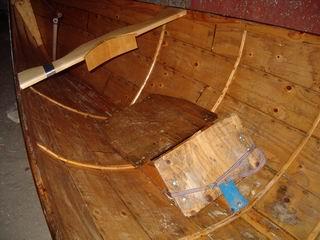 |
An uncomfortable seat for the cox. It was most uncomfortable until
I installed the backrest.
|
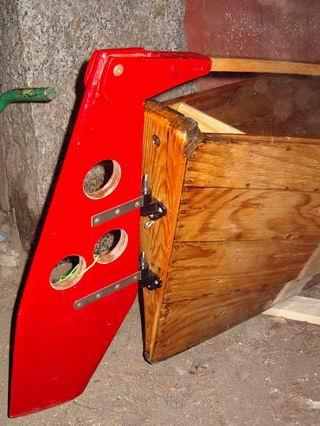 |
The rudder is a shortened and lightened D4 rudder. Shortened to decrease
drag and avoid hitting submerged rocks. On an "around the island" race
the shortest course may not always be the deepest one.
|
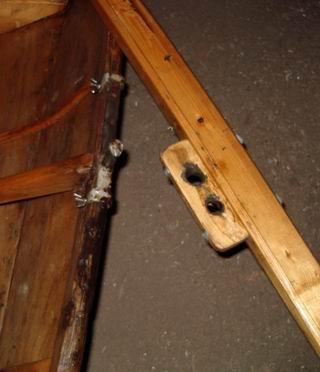 |
The oarlocks are of ring-pin type. The ring is made of wood. Two gearing
alternatives are provided by two ring holes.
|
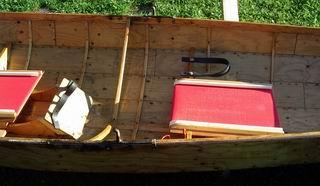 |
Foot stretchers are rather primitive. The next improvement should
be to replace the fixed straps with adjustable ones.
|
Top of the page.
Back to main page.
Mind You, this is not an official translation. Just to give You the idea of
the spirit of the game. Still, I'm doing my best to be as accurate as possible.
1. The boat has to be build of wood, using lapstrake construction. The minimum
strake thickness is 6 mm if plywood and 8 mm if plain wood.
My comment:
Most boats, maybe 99%, are of plywood. Lightweight luan seems to have replaced
the earlier used pine or spruce. Lightest boats weight around 40 kg (90 lbs).
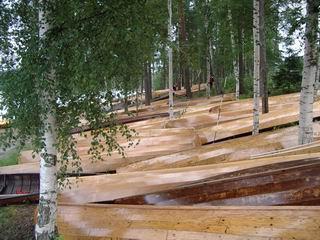
As can be seen on the picture above, only plywood boats.
2. The maximum length of the hull is 6.5 m. The internal width, measured at the
greatest beam, has to be at least 1 m measured 20 cm below the sheerline.
The external width has to be at least 75 cm measured 12 cm above the lowest point of
the bottom. An external keel narrower tham 5 cm need not be taken into account
in the 12 cm measure. The external keel, bow stem and stern stem shall not, at
any point, protrude more than 5 cm, measured from the planking.
My comment:
This rule has made the boats very narrow, close to the 1 m limit.

Most boats are close to this.

The corresponding
.hul file.
I wonder
if it would be worth experimenting with slightly wider boats. Giving more spread
to the rowlocks, enabling the use of longer sculls and/or less overlap. Many seem
to scull with overlaps extending 30 cm (12").
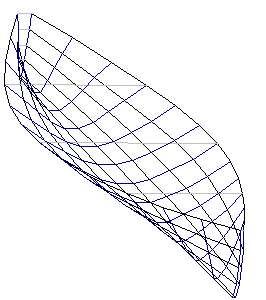
Something like this? The width would allow the use of standard olympic class
scull lengths and gearings.

The corresponding
.hul file.
3. The sheerline must be concave for the whole length of the boat, when viewed from
the side, and convex for the whole length, when viewed from above. Concave frames
are not allowed. The sheer has to be the outermost point of every cross section.
4. The transom width at the sheerline has to be at least 12 cm.
5. The bow and stern have to be clearly outwards inclined, in the national fashion.
My comment:
This rule is broken by almost every boat! The vertical steam ship bows of most racers
have absolutely nothing to do with the national fashion. The rule is too indeterminate
to be enforced.
6. The height of the bow and stern have to be at least 55 cm, measured between a
straight line drawn between the highest points of the bow and stern sheer, and the
lowest point of the mid frame (internal measurement).
7. The seat rule changed in 2005. Before 2005 the seat rule was:
The seats have to be made of wood and they have to be fixed. A fixed cushion is
allowed. In addition to this, a cushion is allowed on the rowing pants. The maximum
combined thickness of the cushions is 2 cm.
My comment:
Although sliding seats are not (yet) allowed, it is allowed to slide on a fixed seat.
Fixed seats are covered with a nylon mesh that together with the sliding pad on the
rowing pants creates a slippery pair. Lubrication is commonly used and so an
"almost sliding seat" effect is created.
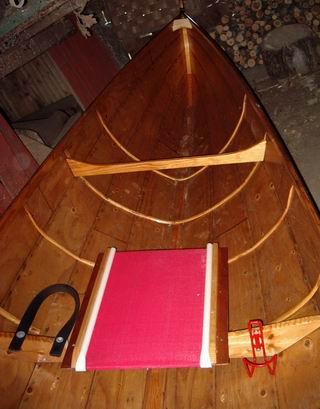
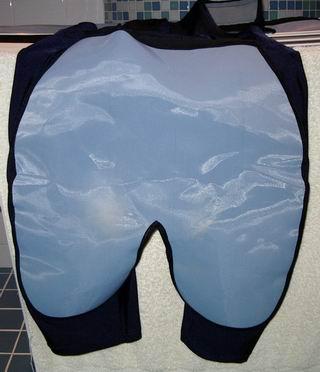
The manufacturer of my seat tops recommended Johnson's Pled for the lubrication.
I prefer the citrus flavour :-)
From year 2005 the seat type is not limited by the rules. That is, real
sliding seats will come to play. That much for the tradition. O tempora,
o mores!
8. The sculls shall be made of wood.
My comment:
Most boats use hatchets, the spoons being very small compared to olympic class
spoons, however.
9. The oarlocks must be of traditional ring-pin construction. The material of the
ring can be freely selected. All kinds of solutions, that enable changing the scull blade
pitch during the stroke are forbidden. The centre line of the oarlock must not lie
outside the sheer. A one bladed wooden steering paddle (the blade may be glass
reinforced) is allowed. Fins and rudders are prohibited.
My comment:
No outstretchers, no feathering the blades. The absence of feathering may be the
reason for small spoons.
10. Foot stretchers may only be attached to frames or the keel.
11. Structures supporting the shape of the boat may only be made of wood, supports
made of other materials are prohibited. A fixed metal support between the mid seat
end the bottom is allowed.
12. Two spare sculls, a bilge water removal device and a paddle are allowed.
A rear mirror fixed to the boat is allowed. Each crew member has to take care
of her/his personal safety equipment.
13. All kinds of advertisements attached to the boat are allowed
(excluding tobacco and alcohol).
14. All kinds of deck structures are prohibited.
15. Any boat that is built clearly against the spirit of these rules or clearly
agaist the tradition may be disqualified.
Top of the page.
Back to main page.
Again, mind You, this is not an official translation. Just to give You the idea of
the spirit of the game. I have left out some small construction detail, so if
You inted building one for a serious race, get the complete rules.
1. The boat has to be built of domestic wood, using lapstrake construction.
The minimum strake thickness is 9 mm if plywood and 12 mm if plain wood.
2. The maximum length of the hull is 12 m, measured from the outermost point of the
bow stem to the outermost point of the stern stem. The external width of
the boat shall be 1.8 - 1.95 m.
3. Concave cross sections are not allowed within the length between the oarlocks.
Concave shapes in the sheerline are prohibited, when viewed from above.
4. The transom width at the sheerline has to be at least 20 cm.
5. The bow has to be clearly outwards inclined and curved, in the national
fashion. A metal protective cover is allowed. The cover has to follow the
shape of the bow and it shall not protrude more than 1 cm from the stem.
6. The height of the bow and stern have to be at least 30 cm, measured between a
straight line drawn between the highest points of the bow and stern sheer, and the
sheer at the mid frame.
7. At the mid frame (or at the lengthwise centre of the boat) the sheer has to
be at least 50 cm above the lowest point of the frame.
8. As with the small boats, the seats are not limited to fixed ones starting
from year 2005. The older rule was:
The seats have to be made of wood and they have to be fixed. A fixed cushion is
allowed. In addition to this, a cushion is allowed on the rowing pants. The maximum
combined thickness of the cushions is 2 cm. The construction of the foot
stretchers is free of regulations.
9. The oars shall be made of wood (domestic wood). A maximum of 7 pairs of oars
are allowed. Two spare oars are allowed.
10. The oarlocks must be of traditional ring-pin construction. The material of the
ring can be freely selected. All kinds of solutions, that enable changing the oar blade
pitch during the stroke are forbidden. The centre line of the oarlock must not lie
outside the sheer (the sheer shall not be artificially broadened at the oarlocks).
The oarlock positions in both sheers shall be equal (+- 1 cm).
11. A fixed rudder is allowed, shall be made of wood. A spare rudder is allowed.
12. The boat has to have a device for bilge water removal.
13. All kinds of advertisements attached to the boat are allowed
(excluding tobacco and alcohol).
14. All kinds of deck structures are prohibited.
15. Any boat that is built clearly against the spirit of these rules or clearly
agaist the traditional church boat may be disqualified.
Top of the page.
Back to main page.
The Sulkava 2003 saturday morning race start is going to take place the
following morning under the
bridge in the middle of the picture. The route then follows the strait to
the right.

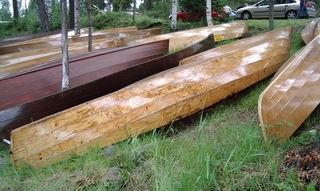 |
Boats lined up on the beach for the morning start.
|
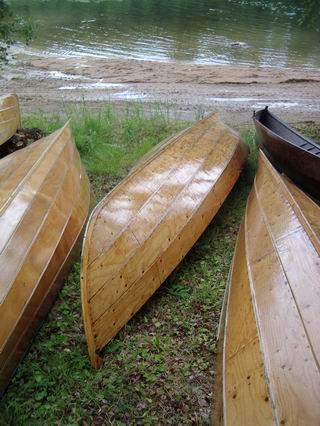 |
There are no boathouses in the middle of nowhere ;-)
|
Our team at work at Sulkava in 2003, at only 5 km from the start.
That's why we still
smile :-)
The total race length used to be 65 km (40 miles) around the Partalansaari
island, the biggest island in the lake Saimaa. In 2003 the island suddenly
shrunk. Now the race length is a mere 58 km (36 miles).
(You didn't believe that, did You? It didn't actually
shrink. Today anyone can check the distance with a GPS, so the organisers
had to moderate it a bit. But it's still the same amount of sweat.)
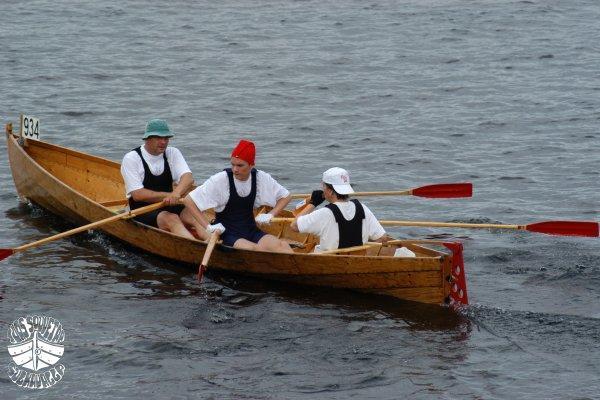
In the end, 6 hrs, 53 minutes and 41 seconds from the start we did not perhaps
smile so much :-)
The fastest small boats make the journey in about 5 hrs, the fastest church
boats in about 4 hrs.
Top of the page.
Back to main page.
















